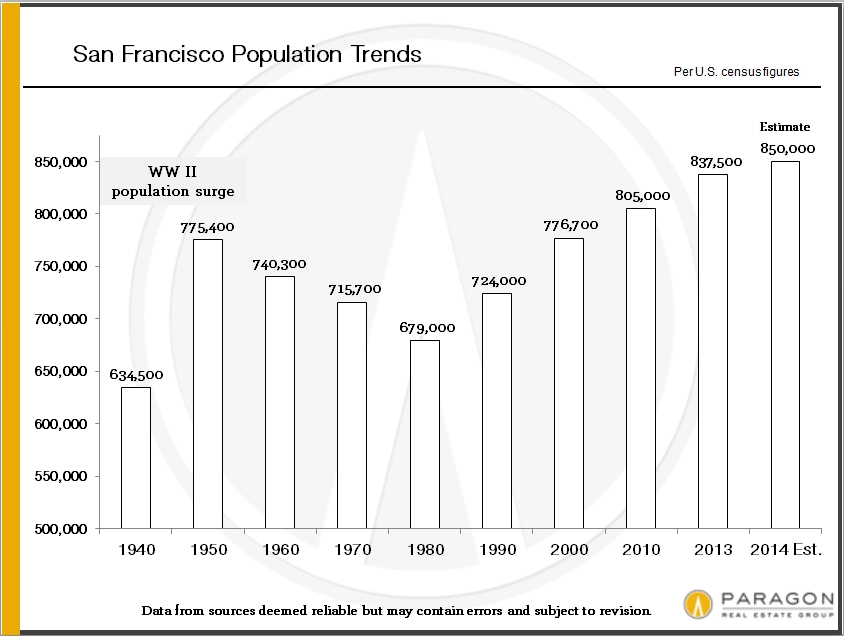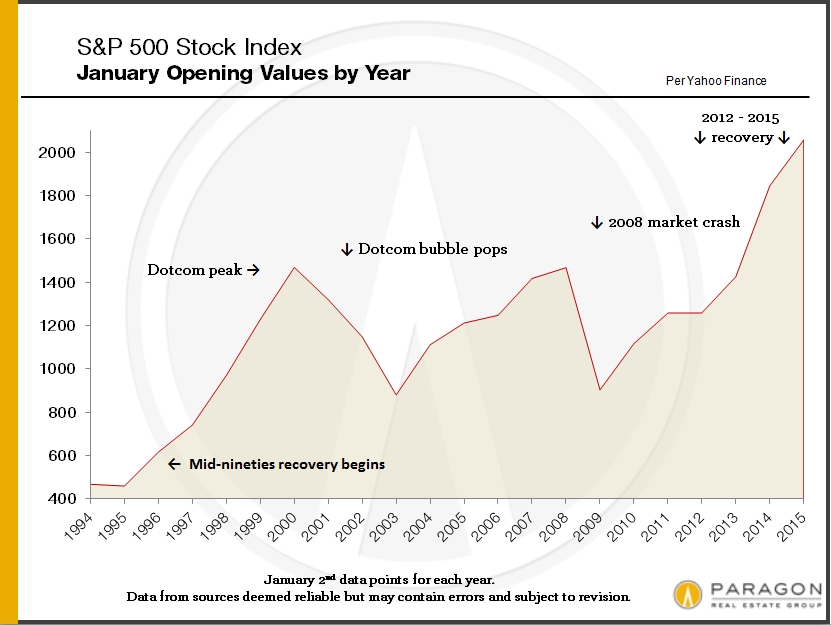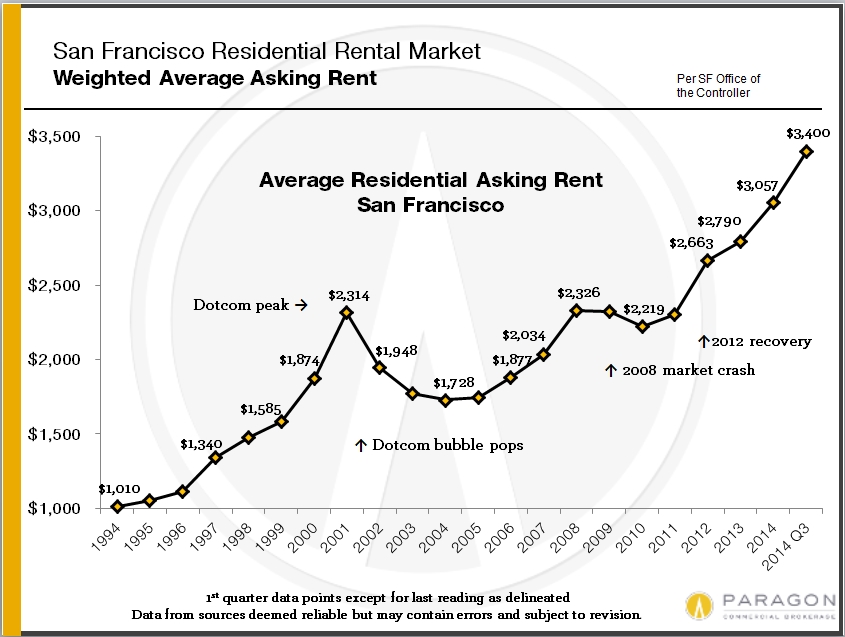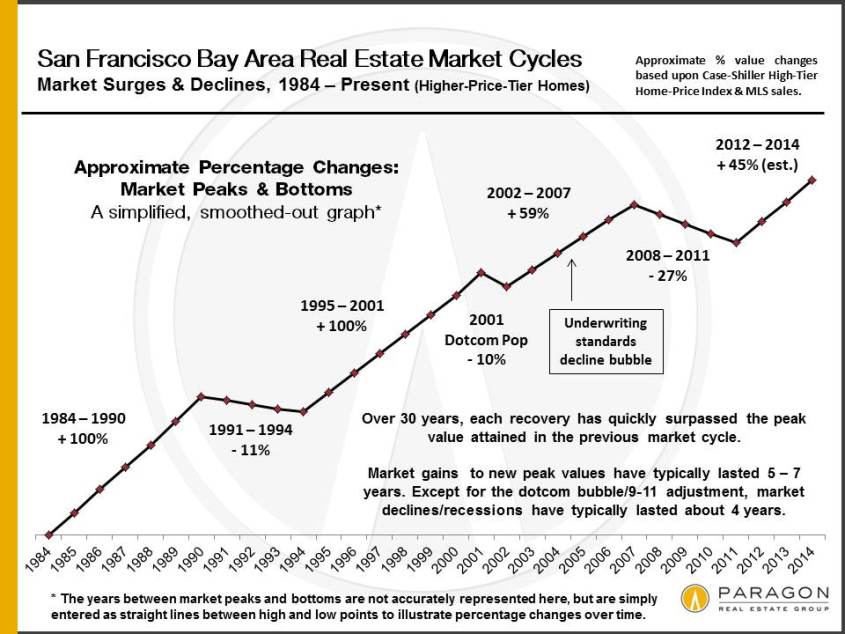Ten Factors Behind the San Francisco Market
Supply, Demand, Money, and Demographics
10 Factors Behind San Francisco’s Real Estate Market
Why is San Francisco’s housing market the way it is now? What's behind the often intense competition among buyers and the surge in appreciation since 2012? It’s worthwhile to take a step back and consider the main factors at play, some of which reflect general macro-economic trends and some of which are specific to the city itself:
1 - Population growth: San Francisco has recently been adding approximately 10,000 new residents per year and new home construction has not come close to adding enough additional housing units to meet increase demand. (And more would move here if they could find a place to live.) New construction is booming again in the city, but much of it is in very expensive, luxury projects and a large percentage of buyers for such real estate - maybe as much as 40 to 50% - are wealthy people with primary residences elsewhere, buying second or third homes or units as investments. They are "sopping up" much of the added inventory being constructed without relieving population pressures. All in all, it appears that it will be a while before enough new units arrive (to rent or to buy) to substantially change the existing high-demand/low-supply market dynamic.
2 - Employment growth: San Francisco now has the highest number of employed residents in its history and job numbers continue to grow as new companies start up and existing ones expand. They're not just in high-tech, but in science, medicine, construction, retail and financial services as well. Many of these new jobs are very well paid.
As Socketsite put it succinctly (1/2015), "Around 7,500 units of housing have been built in San Francisco since January 1, 2010. Over the same five years, the number of employed residents has increased by 74,000. And in a nutshell, that ten-to-one ratio has been driving the trend in rents and property values." We believe there are other factors at play, hence this article, but this is a big one.
3 - Surging stock market: The S&P 500 is up over 60% from January 2011 to January 2015. The affluent have benefited most from the recent, large increase in the value of financial assets, and San Francisco has one of the most affluent populations in the country. When people feel wealthier, they spend more on homes, second homes and real estate investment properties.
4 - Brand new wealth: Thousands of newly affluent residents – including significant numbers of millionaires and even billionaires – have been created in the Bay Area in recent years from stock options, IPOs and company sales. This is super-charging the “wealth effect” on the market. According to Wealth-X, San Francisco ranks 3rd in the nation for number of "ultra-high-net-worth" residents.
It's also interesting to note that: "San Francisco ranks first among U.S. cities in income mobility — the opportunity to rise upward on the income scale — thanks to its schools, its growing economy and its compact physical size that doesn’t produce walled-off divisions." (San Francisco: a city pushed to new limits and opportunities)
5 - High rents: Purchasing a home in San Francisco, with the attendant multiple tax benefits and equity accrual (as well as the possibility of future appreciation), often makes compelling financial sense if the alternative is to pay an extraordinarily high rent.
6 - Low interest rates: from 1996 to 2006, the average interest rate on a 30-year fixed rate loan was approximately 6.3%. As of December 31, 2014, it was under 4%. That 37% reduction in the cost of financing makes an enormous difference in affordability and the ongoing cost of housing.
7 - Renting instead of selling: High rents and low interest rates have convinced some owners who would have sold their homes to rent them out instead. The Airbnb rent-to-tourists option is probably adding to this. This further depresses the supply of new listings coming on market, exacerbating the inventory shortage: 2013 to 2014 for the 1st half, the number of new MLS listings is down 7.5%, when higher prices would typically be expected to increase it.
8 - Work there, live here: A relatively recent development, many of the people working or taking new jobs in Silicon Valley high-tech and bio-tech now insist on living in the city. The “Google bus” phenomenon is just one illustration of a trend which puts considerable additional pressure on our housing market.
9 - Magnet effect: San Francisco, a small city of 7 by 7 miles, is now the capital of perhaps the fastest growing, most lucrative, highest-prestige business segment. It is also in one of the most beautiful, best educated, most tolerant and culturally rich metropolitan areas in the world. That makes the city a magnet for smart, creative, ambitious people from all over the planet and they are willing to pay a premium to live here.
10 - Limited supply: Almost two thirds of the city’s housing is in rental units, much of it under rent control. The number of homes suitable for owner-occupancy and available to purchase each year is relatively small: As an example, the SF homes market is less than half the size of the markets in either Alameda or Contra Costa counties.
And this chart below is a simplified, smoothed-out and approximate look at the last few real estate cycles in San Francisco, illustrating estimated percentage changes in home prices from successive peaks and bottoms of the market. The years between these high/low points are simply depicted here as straight lines (which does not reflect reality). Different market segments have experienced varying appreciation and depreciation rates over the years and how this chart applies to any specific property is unknown without a tailored analysis.






